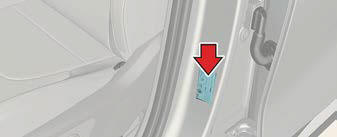Kia Sportage: Tires and wheels
For proper maintenance, safety, and maximum fuel economy, you must always maintain the recommended tire pressures and stay within the load limits and weight distribution recommended for your vehicle.
Recommended cold tire inflation pressures
All tire pressures should be checked when the tires are cold. "Cold Tires" means the vehicle has not been driven for at least three hours or driven less than 1 mile (1.6 km).
Recommended pressures must be maintained for the best ride, vehicle handling, and minimum tire wear.
For recommended pressure, refer to "Tires and wheels"
All specifications (sizes and pressures) can be found on a label attached to the driver's side center pillar.

WARNING
Tire underinflation
Inflate your tires consistent with the instructions provided in this manual.
Regularly check the tire inflation pressure, and correct it as needed; at least twice a month and before any long trips on the road. If you fail to observe this precaution, you may be driving on underinflated tires, which may not only compromise your vehicle's driving stability, but may also lead to tire damage and the risk of an accident. This risk is much higher on hot days and when driving for long periods at high speeds.
Failure to maintain specified pressure may result in excessive wear, poor handling, reduced fuel economy, deformation of tire and/or wheel, harsh ride conditions, possibility for additional damage from road hazards, or result in tire failure.
Tire pressure
Always observe the following:
- Check tire pressure when the tires are cold. (After vehicle has been parked for at least three hours or hasn't been driven more than 1 mile (1.6 km) since startup.)
- Check the pressure of your spare tire each time you check the pressure of other tires. (if equipped)
- Never overload your vehicle. Be careful not to overload a vehicle luggage rack if your vehicle is equipped with one.
- Warm tires normally exceed recommended cold tire pressures by 4 ~ 6 psi (28 ~ 41 kPa). Do not release air from warm tires to adjust the pressure or the tires will be underinflated.
WARNING
Tire Inflation
Overinflation or underinflation can reduce tire life, adversely affect vehicle handling, and lead to sudden tire failure. This could result in loss of vehicle control and potential injury.
- Checking tire inflation pressure
- Wheel alignment and tire balance
- Tire sidewall labeling
- Tire terminology and definitions
- Snow tires
READ NEXT:
 Checking tire inflation pressure
Checking tire inflation pressure
Check your tires once a month or
more.
Use a good quality gauge to check
tire pressure. You cannot tell if your
tires are properly inflated simply by
looking at them. Radial tires may
look pro
 Wheel alignment and tire balance
Wheel alignment and tire balance
The wheels on your vehicle were
aligned and balanced carefully at
the factory to give you the longest
tire life and best overall performance.
If you notice unusual tire wear or
your vehicle pul
 Tire sidewall labeling
Tire sidewall labeling
This information identifies and
describes the fundamental characteristics
of the tire and also provides
the Tire Identification Number (TIN)
for safety standard certification.
The TIN can be
SEE MORE:
 Output Speed Sensor
Output Speed Sensor
Description and Operation
Description
The output speed sensor is a vital unit that measures the rate of rotation of
the transaxle's turbine shaft and output
shaft, and delivers the readings to the TCM. The sensor provides critical input
data that's used in feedback control,
dam
 Repair procedures | Components and Components Location | Transaxle Control Module (TCM)
Repair procedures | Components and Components Location | Transaxle Control Module (TCM)
Adjustment
TCM Learning
When shift shock is occurred or parts related with the transaxle are replaced. TCM learning should be performed.
In the following case, TCM learning is required.
Transaxle assembly replacement
TCM replacement
TCM upgrading
1. TCM learning conditi
Content
- Home
- Kia Sportage - Fifth generation (NQ5) - (2022-2025) - Owner's Manual
- Kia Sportage - Second generation (JEKM) (2005-2015) - Body Workshop Manual
- Kia Sportage Third generation (SL) - (2011-2016) - Service and Repair Manual
- Sitemap
- Top articles